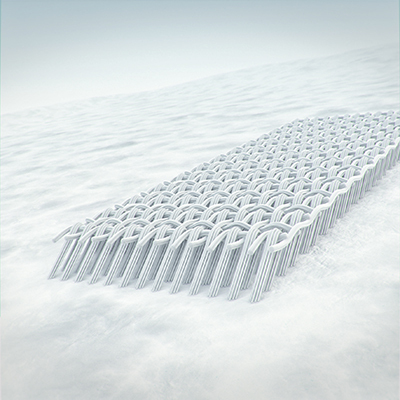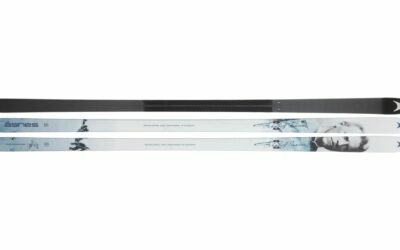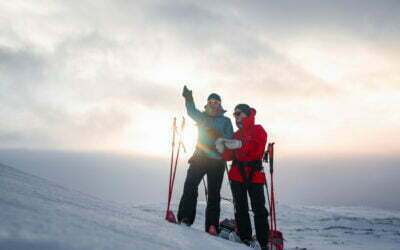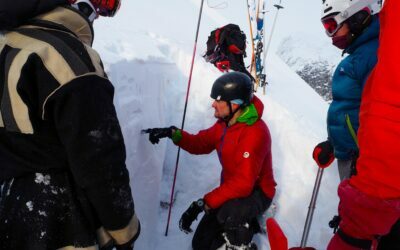What’s in a skin?
1. A directional plush

«Vurder bruk, behov, fysisk form og teknikk når du velger hvilken fell og hvilket materiale du skal ha i din fell. Hvis du er en vanlig skiturist eller legger ut på langturer, kan du med fordel velge en fell som er lettere og som gir god glid. Hvis du bare sporadisk går på ski eller er ny i sporten, kan du spare penger og velge en nylonfell for deres holdbarhet og utmerkede grep.
The surface in contact with the snow is a plush material. The nature of the plush determines the skin’s capacity to grip and glide. These properties vary depending on the material used (nylon, mohair, or blend) and how the fibres are woven (thicker or thinner, longer or shorter, more angled or less). As a general rule, skins that glide well have a slightly weaker grip, and vice versa.
The composition of long and short hairs plays a great role in a skin’s capacity for glide. As counter-intuitive as it sounds, skins with many long hairs actually glide better. If you study sealskin, which is what all modern traps attempt to imitate, you’ll see that sealskin consists of several layers of both long and short hairs.
Mix skins, with a combination of mohair and nylon, offer a good compromise between good glide, grip, weight, durability, and price.
Life: approx. 120.000 m
Skins – the alpine tourer’s best friend!
2. Impregnation and treatment

Skins are commonly treated with various types of impregnation. A good skin has the right combination of long and short fibres and a treatment that won’t cause environmental issues. Skins are treated to ensure the best possible glide, the least uptake of melted water, and for the functioning of the fibres’ properties: grip on the backslide, glide on the forward slide.
Today, fortunately, most reputable skin-manufacturers have completely cut out the use of fluorines such as PFOA and perfluorocarbons (PFCs). Perhaps the most important treatment is to prevent skins from absorbing liquid water. This is the way to “glomming”, which eventually leads to ice-covered skins that neither grip nor glide like you want.
Glomming occurs in several ways. Wet fibres can freeze when the temperature changes. Flakes of snow attach themselves to the frozen plush, collecting more flakes of snow. Ice builds up when snow melted by friction refreezes.
Fibres are dyed, too. The arrangement and treatment of the fibres constituting a skin’s plush plays a crucial role; the density, arrangement and angles are what separate the really good skins from the less sophisticated skins.
3. Lining, backing and membrane

The lining of the skin (or “backing” as some call it) is often made of a textile like cotton. This is the foundation and anchor of the skin’s fibres.
The lining also functions as a membrane; in some cases the cotton weave is also combined with a rubber membrane to prevent water penetrating through the plush material in contact with the snow and damaging the glue. If the glue’s exposed to a lot of moisture, it dissolves or gets leached away; obviously, this is an issue for a skin primarily attached by adhesive. Good skins have treated layers and resistance to saturation.
4. Glue or adhesive coating

All skins have some form of adhesive on the face lying against the base. This is essential if the skin is to stay firmly attached.
Experience from manufacturers and those most active in the mountains tells us that a skin with a good HotMelt glue works best. Cold and wet conditions are challenging for good adhesion between ski and skin. The right glue, in the right quantity, is crucial. In general, a skin sticks to the ski better when temperatures are slightly warmer than when it’s cold or very wet.
There are skins with a coating of silicone or other hydrophobic substances. But the vast majority of skins use a good glue and seek to solve the issue of saturation through various means.

Waxless or waxable skis?
Buying new skis and not sure whether to choose waxable or waxless bases? Maybe you think grip wax is tricky. Maybe you find the convenience of waxless is enticing. Here’s your path through the pros and cons (and the science!) of both…

Eight reasons to take a course in avalanche rescue
Avalanche rescue is an essential skill, required by all of us who visit avalanche terrain. No one wants to have to use these skills – but if you ever need them, you need to have them down. True, the most important thing is to avoid being in an avalanche in the first place. But if something were to happen, every second counts. And this means training.

First aid essentials for a dog
You don’t need to go over the top when putting together first aid equipment for your dog. But it’s good to be prepared for the most common and critical situations that can arise out in the wilds.

13 tips for better orienteering.
Few of us set out into the winter mountains when the weather’s bad and visibility’s poor. And we’re careful for good reason. It’s risky. When nature shows its muscles, it forces us to reflect. Even so, Norway’s a country with plenty of mountains and even more weather. If we only headed out when the sun was shining, the season would be very short. We head out when the weather’s less than perfect – which means we need to be able to find our way with a map and compass. Here are 13 tips for using a map and compass, then, for those of us hitting the mountains in winter.

An avalanche course: the most valuable “gear” you can get
New gear is the best. Everyone loves gear. In fact, the only things better than gear are skiing and staying alive. To maintain this state of affairs, a knowledge of avalanches, navigation, terrain and the basic physics of snow is essential – it means the power to travel safely, on your own terms.

Prepping and waxing cross-country skis for the backcountry – simply
When we wax cross-country BC skis, the best approach is often the simplest. If you’re in the mountains for several days, you want something that works, well enough, without fuss, for most of the day. Luckily this isn’t rocket science